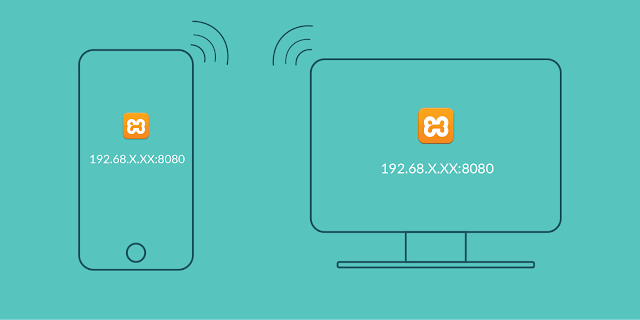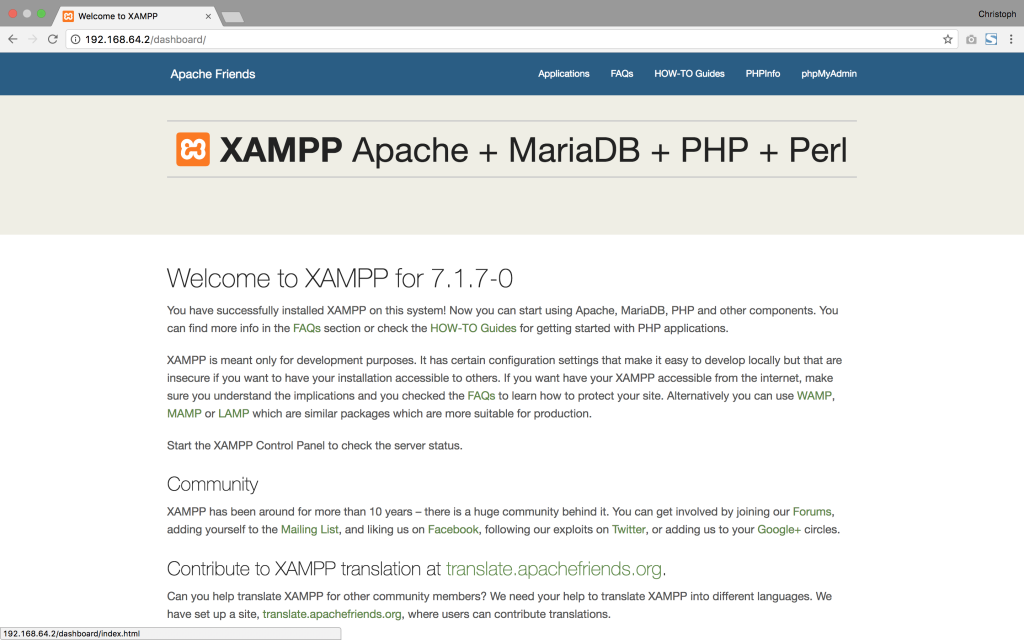

- Download xampp for mac os how to#
- Download xampp for mac os install#
- Download xampp for mac os password#
# In this file, you can use all long options that a program supports. # ~/.my.cnf to set user-specific options. # installation this directory is /Applications/XAMPP/xamppfiles/var/mysql) or # mysql-data-dir/my.cnf to set server-specific options (in this # an important part, or systems up to 128M where MySQL is used together with # This is for a system with little memory (32M - 64M) where MySQL plays The highlighted portion of the config file below is where you change the port number: my.cnf # Example MySQL config file for medium systems. Click Open Conf File and change the port number in the file.The Configure window for XAMPP’s MySQL service. When starting XAMPP’s MySQL, if it says that it cannot connect to the port number, then changing it to a new one will help. If you are unable to restart MySQL after, you can also try this command to directly start XAMPP’s MySQL server: $ sudo /Application/XAMPP/xamppfiles/bin/rver startĪrticle continues after the advertisement: c. Tip: If you have multiple mysql processes and don’t know which want to stop, you can also stop ALL MySQL processes with sudo killall mysqld. Restart MySQL in manager-osx and you will be good.Now, you need to kill this process, by using the following command: kill -9, so for me the final command will be: kill -9 362._mysql 362 0.0 0.0 35192992 3396 ? Ss Sun10PM 0:21.82 /usr/local/mysql/bin/mysqld -user=_mysql -basedir=/usr/local/mysql -datadir=/usr/local/mysql/data -plugin-dir=/usr/local/mysql/lib/plugin -log-error=/usr/local/mysql/data/ -pid-file=/usr/local/mysql/data/ -keyring-file-data=/usr/local/mysql/keyring/keyring -early-plugin-load=keyring_file=keyring_file.so In my case, the process is named _mysql, so I need its process ID, which is 362 (highlighted below). After getting processes, you need to get the process ID of the processes named mysql.

This will show you the processes with mysql in its name.
Download xampp for mac os how to#
Here’s a guide (by Apple) on how to do this. Note: To run the following commands, you will need to be able to log in as a root user on your macOS. Instead of using the Activity Monitor, you can also find and close existing mysqld processes using macOS’s Terminal. Killing existing MySQL processes using Terminal Now you are good to GO.Removing existing mysqld processes using the Activity Monitor.
Download xampp for mac os password#
Now provide the User name and password you created. Step 16 :- Go to “htdocs” -> “Joomla” -> search for the “installation” folder and delete it.įinal Step:- Go to your browser type “localhost/Joomla”.
Download xampp for mac os install#
Install it and on the next page you will get a warning“ Delete the installation folder to continue“ Install Joomla in Xampp on Mac Install Joomla in Xampp on Mac Install Joomla in Xampp on Mac

On the last page, you will find an “Install Joomla”. Fill in all the required data and click next. Step 15:- Go to your browser and type “localhost/Joomla”. Click to “New database” and name the database as “Joomla” and click Create. Step 14:- Now You need to create a new database. After that Click on “phpMyAdmin” Install Joomla in Xampp on Mac Step 13:- It will redirect you to a website. Step 12:- Again click to the Welcome page and open “Go To Application”. (ProFTDP) is not needed you can stop that MySQL database and Apache Web Server should be running. Step 11:- Open XAMPP Goto – “Manage server” and start all. After changing the settings to Read & write press the setting option and press “Apply to enclosed items.” Step 10:- Change every setting to “Read and write”. Step 9:- Press the lock button (as shown in next step) and unlock it by providing your laptop’s passcode.


 0 kommentar(er)
0 kommentar(er)
